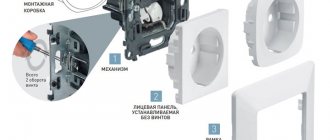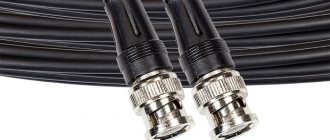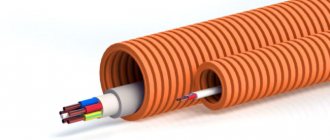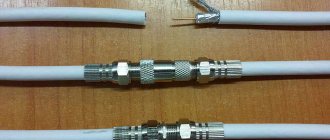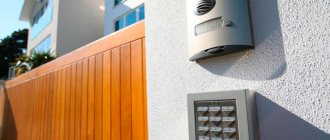When building local networks of various levels and scales, the main connecting interface is a twisted pair cable. 30 years ago he managed to win the coaxial analogue technology war, and today it is the most common type of communication between individual computers and other devices designed to transmit digital data. In particular, it is also used by Internet service providers, delivering network traffic to end consumers.
What is a twisted pair cable?
Interweaving wires in pairs is an invention that is more than 150 years old. Initially, this method of organizing communication was used for telegraph communication, then for a long time twisted pair became the standard for analog telephony. Twisting has proven to be an effective measure to counteract external electromagnetic interference while protecting against internal interference.
Currently, the term “twisted pair” is used primarily in relation to computer networks, having been transformed from two-pair to four-pair.
Structure of a twisted pair cable
Twisted Pair Categories
The main characteristic of any communications is the data transfer speed. In relation to twisted pair, this characteristic depends to a rather small extent on parameters such as the cable material or its internal topology. But they affect other characteristics of the network - its durability, reliability, maximum permissible signal transmission distance, etc.
The most general characteristic is considered to be the VP category; currently all twisted pair cable manufacturers adhere to this classification. As we have already noted, the determining parameter of computer networks is the speed of information transfer. It depends, first of all, on the frequency of current oscillations, which is the analog method of transmitting a unit of data. For this reason, when dividing cables into categories, one of the main characteristics is the frequency range in which the twisted pair is capable of operating. All other parameters are secondary, aimed at maintaining a given oscillation frequency.
Twisted pair categories:
- CAT1 is characterized by a transmission frequency of up to 10,000 Hz; such a cable was previously called “noodles”. Currently, it is used only for laying a telephone cable into an apartment from a panel installed on the landing.
- CAT2 has a frequency band of up to 1 MHz, which for a four-core cable corresponds to a speed of 4 Mb/s. This wire is used to connect the telephone to the apartment box.
- CAT3 – operates at 16 MHz (10 Mb/s over long distances, 100 Mb/s up to 100 meters).
- CAT4 - 20 MHz cable, practically not used.
- CAT5 is capable of operating at frequencies of about 100–125 MHz (100 Mb/s for two pairs, 1000 Mb/s for four pairs). Currently the most common category for computer twisted pair cables.
- CAT6 has an operating frequency band of about 250 MHz (1 Gb/sec), while the CAT6a variant has an operating frequency of 500 MHz, which corresponds to a speed of 10 Gb/sec.
- CAT7 - a cable capable of operating at frequencies up to 700 MHz, today declared and approved only by the ISO standard
Twisted pair cable marking
The following markings are generally accepted, indicating the method of organizing shielding:
- UTP – cheap unshielded cable (may be designated U/UTP);
- FTP – a cable in which all pairs had a common shield (F/UTP);
- S-FTP – common double shield for all pairs with foil-coated aluminum core and tinned copper wire conductors (SF/UTP);
- STP – presence of a screen for each pair (U/FTP);
- F/FTP – separate screens for all pairs plus a common screen made of aluminum foil;
- S/FTP – separate screens for all pairs plus a common one made of tinned copper wire.
Types of cable shielding depending on marking
In general, a screen protects a cable from random and systematic interference that distorts the signal; it is necessary to prevent loss of information. Types of shielding indicate different levels of data protection. They largely determine the cost of the finished product.
Types of twisted pair
In addition to markings indicating the presence and method of organizing the screen, there are other designations used by manufacturers to indicate certain technical features of their products:
- Number of cores: solid – single-core cable, patch – multi-core. Monocores are cheap to produce, so they are the most common. Multicore products are used for complex network topologies in places of multiple bends. They are mainly used in the production of patch cords (a section of cable of a given length terminated with jacks for connecting devices).
- Core diameter. The range used is 0.40–0.64 mm. Cable products of categories 5–6 are made from conductors with a diameter of 51 mm and are designated 24AWG (American marking standard). A budget, often uncertified cable is made from 0.40–0.50 mm wire - for an apartment, the choice of such a twisted pair would be quite justified.
- Number of pairs When building complex communication systems, their number can reach thousands, but for computer networks the standard is 4 pairs (the marking accepted in the USA is 4x2x0.51). The use of all eight cores is required to build gigabit networks; for home use with a throughput of up to 100 Mb/s, two pairs are sufficient. And although such a cable is cheaper, usually in any case they purchase the eight-core version. Two pairs are used for arranging intercoms and alarm systems.
Twisted Pair Contents
We should also talk about marking by shell type:
- PVC – polyvinyl chloride sheath, used mainly for cheap cables;
- PP – polypropylene sheath for cables that can be exposed to high temperatures (up to 140° C);
- PE – a sheath made of dense polyethylene, used for external laying of cables;
- FR – fire-resistant category cable (ability to work in case of fire for a certain time, from 30 to 180 minutes);
- LS – a shell made of a material characterized by low smoke emission during fire;
- ZH is a material that does not emit toxic halogen gases when burned;
- B – cable with an armored sheath in the form of an enveloping steel tape.
There are also modifications of the cable with steel cable, which are used for aerial laying of networks between houses.
Crimping twisted pair 8 cores (4 pairs): color scheme
Crimping a twisted pair cable into 8 cores occurs as follows:
Remove the sheath, outer shields and armor from the cable. The best thing is to have a tool at hand for cutting the cable sheath - a stripper. But if you don’t have one, a utility knife will do.
Unwind the pairs, straighten the cable cores and place them in the order of the color scheme in the photo
Trim all conductors to a length equal to approximately the width of your thumb from the edge of the cable sheath
Install the twisted pair connector. Make sure that all wires are fully seated and that the cable jacket fits into the connector.
Insert the connector into the socket of the crimping pliers and smoothly squeeze their handles until they stop.
The result of crimping a twisted pair into 4 pairs (8 cores)
Standards, certification
When choosing a twisted pair type, you need to understand for what purpose the cable should be used. The Ethernet standard is the most common; twisted pair is sometimes referred to by this term. The standard defines a number of characteristics of a cable network: data transmission speed, maximum distance possible without the use of signal amplifiers, modulation method, etc. However, optical fiber also applies to the same standard.
There are also separate standards applicable when laying SCS, and for structured cabling systems the requirements are much stricter.
Connecting a twisted pair cable to an Internet outlet
Over a dozen Ethernet standards have been developed, most of them are outdated (for example, 10BASE5, or IEEE 802.3, often called “thick Ethernet”).
A version of the IEEE 802.3ba standard, developed in 2009, allows data transfer at speeds of up to 40 Gb/sec; there is also a 100-gigabit standard, and a terabit standard is expected.
RJ-45 twisted pair connector
There are three popular standards in the field of SCS:
- American version - EIA/TIA-568С;
- the standard used in Europe is CENELEC EN 50173;
- international version of the standard – ISO/IEC IS11801-2002.
Expert opinion.
LAN-ART twisted pair expert - Evgeniy Nikolaevich Berezkin.All standards relating to the construction of structured cabling systems on twisted pair guarantee its performance for 10 years or more.
Crimping schemes
The direct scheme is used to connect different types of network devices (for example, a computer and a router), as well as to combine two hubs or routers into one local network. This crimping scheme is the most commonly used in local networks.
The crimping procedure for an eight-core cable used in gigabit LANs is as follows:
In twisted pair cables used in local networks operating at a speed of 100 Mbit/s , the following direct crimping order is used:
A crossover (reverse) circuit is needed to connect two computers directly , without using hubs or switches. Gigabit crossover twisted pair cable is crimped as follows:
Ways to combine multiple pdf files into one
Reverse wire diagram for a local network operating at a speed of 100 Mbit/s .
To connect other devices, such as network printers, IP cameras and other similar devices, the crimping diagram is usually written in the instructions for the connected equipment.
Methods for determining the quality of a twisted pair cable
To determine which twisted pair cable is best for the Internet, experts advise paying attention to the brand name. Among European manufacturers, it is worth noting Reichle De-Massari (Switzerland), Mollex (USA) has a good cable. The remaining brands found in Russia are mainly from China (or Taiwan), although the labeling may be different if the customer so desires.
The second criterion we pay attention to is the material used to make the cores. Copper is the standard for twisted pair, but recently you can often find bimetallic conductors, which are inferior in quality to copper ones. They are steel (CCS) or aluminum (CCA) wire clad with a thin layer of copper.
Cable composition: twisted pair
Such products are more affordable, but have a number of disadvantages that are not typical for pure copper cores:
- such conductors are not fixed securely enough in the connectors, forming a so-called “floating” contact;
- there is a limitation on the length of bimetallic twisted pair sections (up to 25 meters at 100 meters for a classic copper cable);
- When a twisted pair is inserted into a connector, significant fluctuations in wave impedance are possible, which affects the stability of signal transmission to the end device;
- in case of damage or the need to re-lay the cable, one cannot count on maintaining the previous characteristics;
- for cables with a steel core, the maximum information transfer speed will be within 10 Mb/s, for conductors with an aluminum core – up to 100 Mb/s.
It’s quite simple to make sure that you have a copper-plated vein in front of you. It is enough to try to scrape off the top layer with a knife. If silvery metal appears under the copper, you can rest assured that this is a twisted pair of bimetallic conductors. By the way, it is not possible to solder a copper-plated cable with a regular soldering iron. However, most Internet service providers use this cheaper type of product when laying the cable from the panel to the end user.
Finally, the quality of a twisted pair can be judged by such a characteristic as the thickness of the cores. The larger the diameter, the better the quality of the cable; for well-known manufacturers it ranges from 0.51 mm. A core thickness in the range of 0.4–0.5 mm indicates a low-quality product.
Most often, thinner cores can be seen on a pair of brown and blue colors, since they are not used for 100-Mbit networks.
And the last criterion for quality control is the availability of a certificate. Large manufacturers certify their products, but small ones do not, because it is expensive.
Crimping RJ-45 cable
Before you get down to work, you need to fully learn the theoretical part of the question so that you don’t have to redo the mistakes you made. Although, all the same, if you are taking on this task for the first time, we advise you to buy several spare connectors (they cost 2-3 rubles apiece) to practice.
Let's see how to make a direct connection step by step, since we encounter it most often; after all, direct connections of computers to each other are used less and less today.
Table 2. Direct connection instructions
| Steps, photo | Description |
| Step 1 – preparation | We prepare all the necessary equipment. It’s better to sit at an empty table so that all the small details are at hand and don’t get lost anywhere. Measure the required piece of cable and cut it with wire cutters. |
| Step 2 – stripping of insulation | We take a stripper and remove the layer of outer insulation from the end of the cable, exposing about 2 cm of the internal cores. |
| Step 3 - core separation | For convenience, divide the wires in pairs, by color. Also inside you will find a fiberglass thread that can be cut. Bend the wires to the sides to make a cross like in the photo. |
| Step 4 – unwinding the pairs | Now all the pairs need to be untwisted so that each core runs separately from the others; the direction of our cross remains unchanged for now. |
| Step 5 - Laying the Wires in a Row | We lay out the wires exactly according to the intended diagram. Press them tightly against each other and hold them with your fingers. The first in the scheme will be white-green, and the last will be brown. |
| Step 6 – trimming the cores | To prevent long wires from interfering with installation, the wires must be cut at the same level - we use wire cutters for this. The width of your finger can be used to determine the overall length, as shown in the photo. |
| Step 7 - installing the wire into the connector | Next, we insert the cable into the inlet hole and push it inward so that the cores fall into the channels provided for them. |
| Step 8 - crimping process | Next, take a crimper, place the connector in the appropriate socket and squeeze the handles of the tool. You need to squeeze firmly, but gently. As a result, we will get a strong connection that will be very difficult to break, even if we try very hard. |
After we have crimped the first end, we move on to the second and proceed in exactly the same order.
You can also crimp the cable through a cap, which will further strengthen the connection and protect it from mechanical damage.
Connector with cap
Crimping without crimper and other alternatives
If you don’t want to spend money on a tool for one-time crimping, which is quite logical, you can use a small flat-head screwdriver for your purposes.
The task is to press the terminals inward
We proceed according to the scheme described above until we reach the point of crimping the cable. Place it on a hard, flat surface with the contacts facing up. We take a screwdriver and press it on the contacts one by one. Be sure to wear a glove on the hand that holds the cable, otherwise it can be damaged by a tool that comes off. In the process, you will understand how the knife protrusions penetrate under the insulation and your work will go faster. We press hard, otherwise reliable contact will not work. Make sure that the contact is recessed slightly below the edges of the connector body. Place a rag under the cable to avoid accidentally damaging the table surface.
Fixing the connector on the insulation
After you have crimped all the contacts, carefully insert a screwdriver into the clamp to securely secure the connector to the cable. We do the same with the other end of the cable. After work, you will notice that the contacts are slightly damaged by the screwdriver; the crimper does not give such an effect.
Now take the cable, install it into the network and check its functionality. If the result is negative, then do not rush to blame your work, perhaps the problem is something else, check all the components of the network:
- If you have a cable that is known to work, replace the one you just made with it and see if a signal appears. If there is no such cable, then try connecting another device - this way you can find out if the problem is in the computer.
- Double-check the sequence of wires in the connectors; perhaps you didn’t notice something or simply got it mixed up.
- If such an oversight is discovered, the situation can only be corrected by biting off the end of the wire and installing a new connector.
- Try to press the contacts - perhaps they did not fit into the vein well.
- Also check your router and network settings on your computer - this is also a very common problem.
Such connectors do not need to be pressed
Today you can find crimpless connectors in stores - they are more expensive than usual, but they are popular for their convenience. An example of such a detail is shown in the photo above. It has an opening casing, under which the slots for the wires will be visible. At the end you will see a hint on how to place the conductors to get an oblique or straight connection. Then the casing closes tightly. Please note that it has hard ribs on the inside. They will press the wires deep into the slots where the sharp contacts are located. In general, the principle is exactly the same, but it’s not the blade contacts that are pressed in, but the wires. The result is a high-quality connection without damage, and you don’t need any tools other than a knife and wire cutters for this.
This concludes the review of the topic. We think that if you follow the instructions exactly, there should be no problems with the connection.
Carrying out large-scale renovations almost always includes installing a home electrical network. Consequently, the question arises - which cable to use for wiring in an apartment or house? It would seem, what is the difficulty? The wealth of choice often only confuses the inexperienced consumer. In addition, not all of the samples on sale are suitable for the intended purpose. Therefore, in a special publication we will try to answer what type of cable and why you should choose.
Video - How to crimp a twisted pair cable with an RJ45 connector?
Video - Crimping an RJ45 connector with a screwdriver
Rating of twisted pair manufacturers
Understanding and remembering all the variety of standards and characteristics of twisted pair cables is quite difficult, especially for an untrained user. Therefore, the question of how and which twisted pair to choose for the home is decided by many based on opinions about the manufacturer. We have compiled a small rating that will help determine the quality and its correspondence to the cost of the Internet cable, depending on the brand.
Premium Twisted Pair
The best twisted pair cable is the most expensive, the cost of 1 meter is in the range of 20–25 rubles. But for the money, you get the highest quality cable that can last for decades. Premium level products are typical for the brands Hyperline, SkyNet, Nikolan.
As a rule, such products are not used for residential Internet - it is installed in government agencies, banks, and other companies with high requirements for network quality.
Mid-level cable
When compared with the top level, twisted pair cable of category 5 costs much less, about 15 rubles/meter, and is characterized by quite decent quality and speed. In Russia, the most popular manufacturer of cable products of this quality is the NetLan brand. The scope of application of twisted pair cables in the mid-price segment is large enterprises and offices, but it can also be seen in the private sector.
Budget twisted pair
When choosing a UTP cable for a home network, most users focus on cost. There is nothing reprehensible about this - products from Chinese brands such as CabLAN or Ripo cost about 5 rubles/meter. In the vast majority of cases, this is a cable with copper-clad cores of appropriate quality, quite suitable for building low-budget networks.
Products with copper conductors from the Middle Kingdom are offered at a price of about 10 rubles/meter, and this is the most suitable option for installing the Internet in residential buildings.


